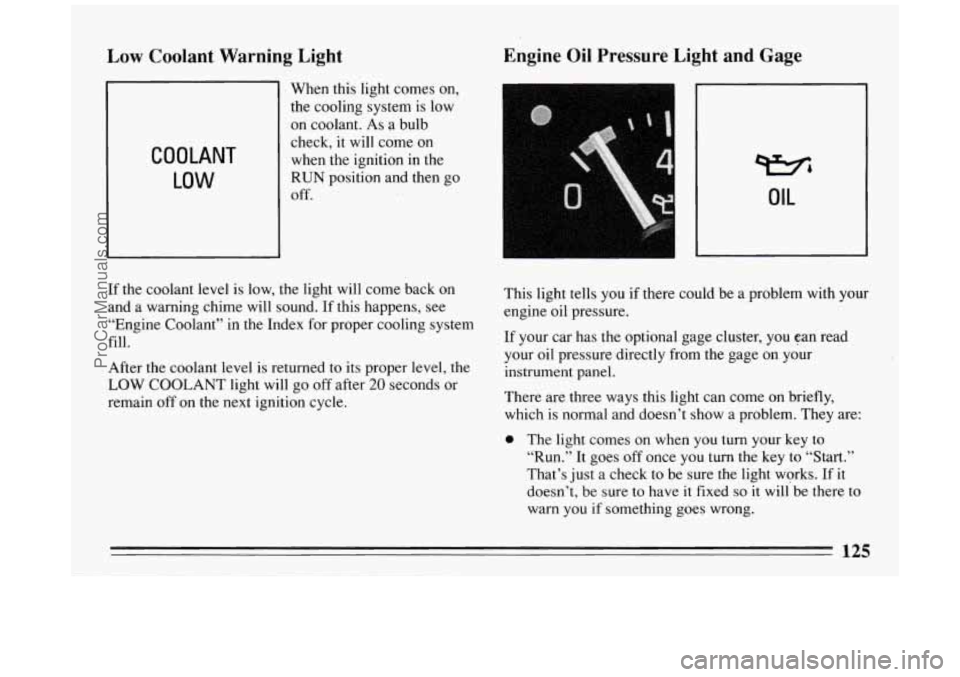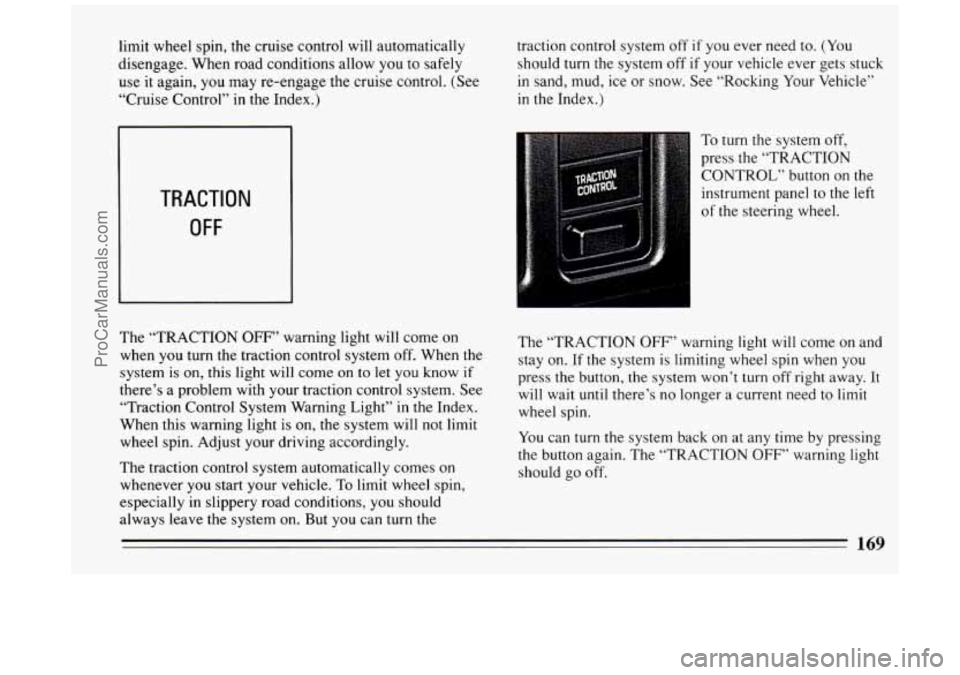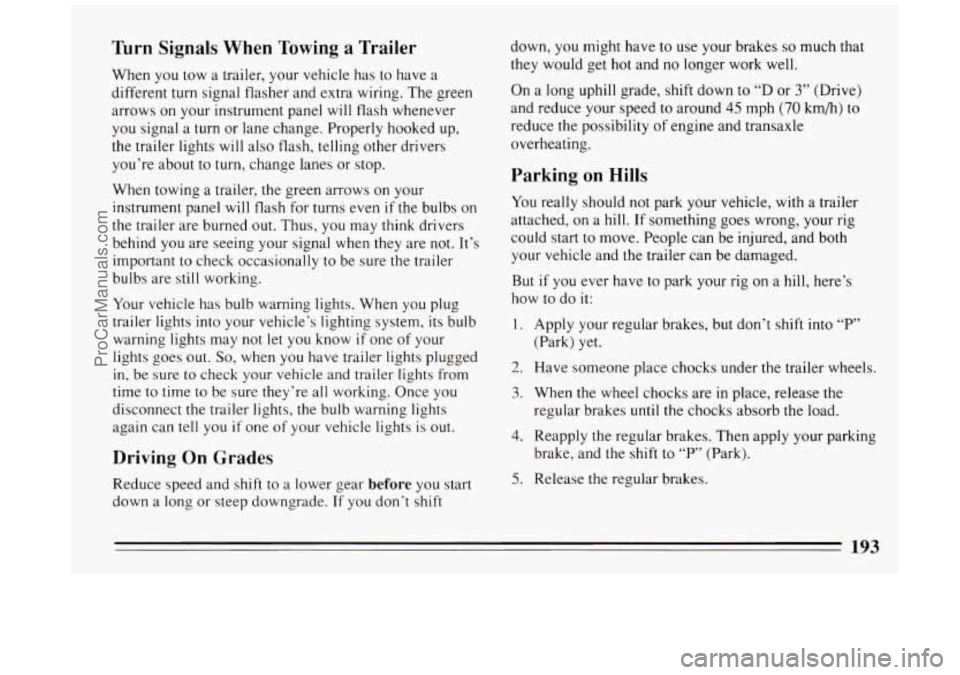Page 127 of 324

Low Coolant Warning Light Engine
Oil Pressure Light and Gage
COOLANT
LOW
When this light comes on,
the cooling system is low
on coolant. As a bulb
check, it will come on
when the ignition in the
RUN position and then go
Off.
Wb
OIL
If the coolant level is low, the light will come back on
and
a warning chime will sound. If this happens, see
“Engine Coolant’’ in the Index for proper cooling system
fill.
After the coolant level is returned to its proper level, the
LOW COOLANT light will go off after 20 seconds or
remain off
on the next ignition cycle. This
light
tells you if there could be a problem with your
engine oil pressure.
If your car has the optional gage cluster, you can read
your oil pressure directly from the gage on your
instrument panel.
There are three ways this light can come on briefly,
which
is normal and doesn’t show a problem. They are:
0 The light comes on when you turn your key to
“Run.”
It goes off once you turn the key to “Start.”
That’s just a check
to be sure the light works. If it
doesn’t, be sure
to have it fixed so it willbe there to
warn you if something goes wrong.
125
ProCarManuals.com
Page 169 of 324
Anti-Lock Brakes (ABS)
Your Buick has an advanced electronic braking system
that will help prevent skidding.
ANT‘ LOCK (@)
ANTI
LOCK
This light on the instrument panel will go on when you
start your vehicle.
When you start your vehicle and begin to drive away, you
may hear a momentary motor or clicking noise. And you
may even notice that your brake pedal moves a little while
this is going
on. This is the ABS system testing itself. If
there’s a problem with the anti-lock brake system, the
anti-lock brake system warning light will stay on.
See “Anti-lock Brake System Warning Light”
in the
Index. Here’s how
anti-lock works. Let’s say the road is wet.
You’re driving safely. Suddenly an animal jumps out in
front of you.
You slam
on the brakes. Here’s what happens with ABS.
167
ProCarManuals.com
Page 171 of 324

limit wheel spin, the cruise control will automatically
disengage. When road conditions allow you to safely
use it again, you may re-engage the cruise control. (See
“Cruise Control” in the Index.) traction control system
off if you ever need to. (You
should turn the system off if your vehicle ever gets stuck
in sand, mud, ice or snow. See “Rocking Your Vehicle’’
in the Index.)
TRACTION
OFF
The “TRACTION OFF” warning light will come on
when you turn the traction control system off. When the
system
is on, this light will come on to let you know if
there’s a problem with your traction control system. See
“Traction Control System Warning Light” in
the Index.
When this warning light is
on, the system will not limit
wheel spin. Adjust your driving accordingly.
The traction control system automatically comes on
whenever you start your vehicle.
To limit wheel spin,
especially in slippery road conditions,
you should
always leave the system on. But you can turn the To
turn the system off,
press the “TRACTION
CONTROL” button
on the
instrument panel to the left
of the steering wheel.
The “TRACTION
OFF” warning light will come on and
stay on.
If the system is limiting wheel spin when you
press the button, the system won’t
turn off right away. It
will wait until there’s no longer
a current need to limit
wheel spin.
You can
turn the system back on at any time by pressing
the button again. The “TRACTION
OFF” warning light
should go off.
ProCarManuals.com
Page 181 of 324
City Driving One of the biggest problems with city streets is the
amount of traffic on them. You’ll want to watch out
for
what the other drivers are doing and pay attention to
traffic signals.
Here are ways to increase your safety
in city driving:
Know the best way to get to where you are going.
Get a city map and plan your trip into an unknown
part
of the city just as you would for a cross-country
trip.
Try to use the freeways that rim and crisscross most
large cities. You’ll save time and energy. (See the
next section, “Freeway Driving.”)
Treat a green light as a warning signal. A traffic light
is there because the corner is busy enough to need it.
When a light turns green, and just before you start to
move, check both ways for vehicles that have not
cleared the intersection or may be running the red
light.
179
ProCarManuals.com
Page 186 of 324
Here are some tips for winter driving:
Have your Buick in good shape for winter. Be sure
your engine coolant mix is correct.
You may want to put winter emergency supplies in
your trunk. Include
an ice scraper, a small brush or broom, a supply
of windshield washer fluid, a rag, some winter outer
clothing, a small shovel, a flashlight, a red cloth, and a
couple
of reflective warning triangles. And, if you will
be driving under severe conditions, include a small bag
of sand, a piece of old carpet or a couple of burlap bags
.to help provide traction.
Be sure you properly secure
these items in your vehicle.
184
ProCarManuals.com
Page 195 of 324

Turn Signals When Towing a Trailer
When you tow a trailer, your vehicle has to have a
different turn signal flasher and extra wiring. The green
arrows on your instrument panel
will flash whenever
you signal a turn or lane change. Properly hooked up,
the trailer lights
will also flash, telling other drivers
you’re about to turn, change lanes or stop.
When towing a trailer, the green arrows on your
instrument panel will flash for turns even
if the bulbs on
the trailer are burned out. Thus, you may
think drivers
behind you are seeing your signal when they are not. It’s
important to check occasionally to be sure the trailer
bulbs are still working.
Your vehicle has bulb warning lights. When you plug
trailer lights into your vehicle’s lighting system, its bulb
warning lights may not
let you know if one of your
lights goes out.
So, when you have trailer lights plugged
in, be sure to check your vehicle and trailer lights from
time to time to be sure they’re all working. Once you
disconnect the trailer lights, the bulb warning lights
again can tell you
if one of your vehicle lights is out.
Driving On Grades
Reduce speed and shift to a lower gear before you start
down a long or steep downgrade. If you don’t shift down,
you might have to use your brakes
so much that
they would get hot and no longer work well.
On a long uphill grade, shift down to “D or 3” (Drive)
and reduce your speed to around
45 mph (70 km/h) to
reduce the possibility of engine and transaxle
overheating.
Parking on Hills
You really should not park your vehicle, with a trailer
attached,
on a hill. If something goes wrong, your rig
could start to move. People can be injured, and both
your vehicle and the trailer can be damaged.
But
if you ever have to park your rig on a hill, here’s
how
to do it:
1. Apply your regular brakes, but don’t shift into “P”
(Park) yet.
2. Have someone place chocks under the trailer wheels.
3. When the wheel chocks are in place, release the
regular brakes until the chocks absorb the load.
4. Reapply the regular brakes. Then apply your parking
brake, and the shift to
“P” (Park).
5. Release the regular brakes.
193
ProCarManuals.com
Page 198 of 324
Hazard Warning Flashers
Your hazard warning flashers let you warn others. They
also let police
know you have a problem. Your front and
rear turn signal lights
will flash on and off.
196
ProCarManuals.com
Page 199 of 324
e I
Press the button in to make
your front and rear turn
signal lights flash
on and
off.
I
Your hazard warning flashers work no matter what
position your key is in, and even
if the key isn’t in.
To turn off the flashers,
pull
out on the collar.
When
the hazard warning flashers are on, your turn
signals won’t work.
Other Warning Devices
If you carry reflective triangles, you can set one up at
the side of the road about
300 feet (100 m) behind your
vehicle.
197
ProCarManuals.com